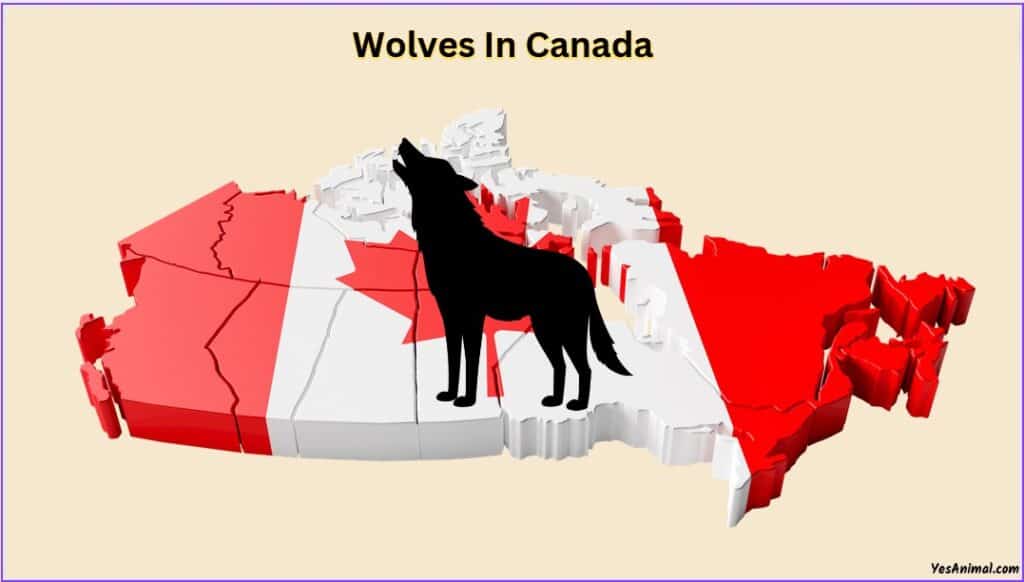Last Updated on November 27, 2023 by Amin Tawar

Wolves are the most widely distributed animal in the world, fundamentally these species were discovered in larger populations and largely restricted to the wilderness or remote areas on most continents and so in Canada.
Below I’ve explained all the things you need to know about the wolves in Canada. So let’s get started.
Are There Wolves In Canada?
Canada is currently home to the gray wolf also called the timber wolf. There are four different subspecies of gray wolf –
Canis lupus occidentalis present in western Canada and most of Alaska;
Canis lupus lycaon in southeastern Canada;
Canis lupus nubilus mostly in southeast Alaska and northeastern & central Canada); and last is the Canis lupus arctos present in the Arctic islands and Greenland called the white or Arctic wolves.
The grey wolf is the biggest of the Canid family and appears in different colors, like white, black, brown, and mostly grey.
They have soft and short under-fur that is shielded by rough, outer hairs. The under-fur is thick and safeguards them from cold temperatures.
In Canada gray wolves are almost the size of German shepherds, but leaner with longer legs, bigger feet, and bushier tails.
They live in packs, which usually consist of about eight members. Each one has its position and behaviors in the group which indicates where they stand in the hierarchy.
How Many Wolves Are Left In Canada?
Presently, about 50,000 to 60,000 gray wolves are estimated to be inhabited Canada, which is known for its second-largest population after Russia.
Historically, wolves have inhabited nearly all parts of Canada, from the northern end of Ellesmere Island to the coasts of the Great Lakes, with the exception of Anticosti Island, Prince Edward Island, and the Queen Charlotte Islands.
Where Are The Wolves In Canada?

Wolves can be seen in different areas across Canada. They are spread throughout the land, from the southern forests to Arctic tundra, and grasslands.
Gray wolves can be mostly found in less settled regions of Canada, from British Columbia to Labrador, in the Northwest Territories and Yukon.
The boreal forest, The prairies, The tundra, and the Canadian Shield are home to many subspecies, like the Eastern wolf and the gray wolf.
Also Check Our Guide On Wolves In US
Which Canadian Province Has The Most Wolves?
The Ontario province of had currently has about 8,000 to 10,000 wolves, which is the biggest population in North America. It is home to several subspecies of wolves including the Eastern and gray wolf.
Various other provinces with considerable wolf populations include British Columbia, Quebec, Manitoba, and Alberta. The exact number of habitants in every province might differ depending on various factors like prey availability, habitat, and human activities.
Are Wolves A Problem In Canada?
Wolves are not typically felt as an issue in Canada, yet, conflicts have been there in a few cases. Wolves are a crucial part of the ecosystem and maintain regulating the population of animals like elk and deer, which overgraze and damage the ecosystems.
When they prey on livestock like cattle or sheep or come near humans in recreational or residential areas, then conflicts do arise. In situations like this, the wolf population is managed through different norms, like non-lethal deterrents, habitat modification, or lethal control measures.
A huge number of wolves live in isolated places and avoid connection with humans. Also, wolves are typically afraid of humans and avoid them when possible. Thus, wolf attacks on pepper in Canada are rare.
Also Check Our Guide On Wolf In California
What Is The Famous Wolf In Canada?
The most well-known wolf in Canada was “Takaya”, which is known as “wolf” in the native speech of the Nuu-chah-nulth individuals on Vancouver Island. Takaya earned overall attention for his unique manners of living independently on a tiny, uninhabited isle on the Salish Sea, off the shore of Vancouver Island, for many years.
In 2012, Takaya was initially spotted and was considered to have traveled from the mainland to the island. He was the symbol of strength and the power of nature to adjust to varying circumstances. However, in 2020, he suddenly departed into the urban area where soon he was shot by shot by a hunter around Shawnigan Lake,
Takaya’s story was highlighted in the BBC documentary and has many large-scale art installations in Victoria. A 150-pound statue of Takaya was made using more than 1000 pieces of shells, driftwood, and kelp and was displayed in the historic Empress Hotel in Victoria.
Are Canadian Wolves Aggressive?
Wolves can be aggressive and even kill whenever possible. But, wolf attacks in Canada on humans are extremely rare.
Wild animals like wolves become aggressive only when they feel threatened or perceive humans as a food source. This is likely to happen in regions where wolves have habituated to human existence or associate food with humans.
Can You Hunt Wolf In Canada?
In certain provinces of Canada hunting wolves is possible. However, hunting laws and regulations vary relying on the region and the exact kind of wolf that is hunted.
In some regions, hunting gray wolves (timber wolves) is permitted during specific periods of the year, but hunting of red wolves is restricted. In other regions, hunting wolves might need a permit or license, and specific hunting practices may be limited.
It is essential to document that hunting wolves is often subjected to debate, as they play a crucial role in the ecological are considered a keystone animal. Also, wolves are protected under specific laws and rules. Therefore, when hunting wolves in Canada, do your study to understand the detailed rules and policies that apply in the region.
Conclusion
And that was everything you need to know about the Wolves In Canada. I hope this article was informative and your queries were answered.
Thank You For Reading!
Our Goto Source For This Guide